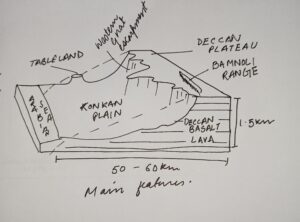Discuss post-mauryan trends in Stupa Making in India. How it was different from Mauryan time?
Deccan Plateau - process involved and influence on the landscape Deccan Plateau was primarily shaped by the volcanic activity during the Late Cretaceous period, this period experienced extensive lava flows resulting in the formation. Now lets delve deeper into the formation of the deccan plateau ERead more
Deccan Plateau – process involved and influence on the landscape
Deccan Plateau was primarily shaped by the volcanic activity during the Late Cretaceous period, this period experienced extensive lava flows resulting in the formation.
Now lets delve deeper into the formation of the deccan plateau
Enormous volcanic explosions allow a large volume of basaltic lava to spread out over a vast area and harden into layers of basalt. The Deccan Traps were formed by these successive eruptions, producing the characteristics stepped terrains with flat-topped plateaus and deep valleys. The tectonic forces caused by the northward movement of the Indian Plate lifted up the Deccan Plateau. Additionally, India’s separation from Africa due to rifting and drifting of the Indian Plate also contributed to its formation.
The landscape has undergone significant changes over the ages due to weathering and erosion. Rivers such as Krishna and Godavari transport eroded material, creating deep valleys and gorges on the plateau hence contributing to the rough topography of the plateau.
Regur or black cotton soil is formed from the decay of basaltic rock rich in iron, which makes it good for farming. Therefore affecting land use patterns.
 Volcanic eruptions, tectonic uplifts as well as long term erosions are some of the factors that have shaped Deccan Plateau presently with its elevated terrain, deep river valleys and fertile soils.
Volcanic eruptions, tectonic uplifts as well as long term erosions are some of the factors that have shaped Deccan Plateau presently with its elevated terrain, deep river valleys and fertile soils.


The Post Mauryan era witnessed significant developments in art and architecture. Though several kingdoms rose on the ruins of the Mauryan Empire, these regional kingdoms took multiple steps to advance the country's rich heritage. In India, we can witness specimens of prominent sculptures during thisRead more
The Post Mauryan era witnessed significant developments in art and architecture. Though several kingdoms rose on the ruins of the Mauryan Empire, these regional kingdoms took multiple steps to advance the country’s rich heritage. In India, we can witness specimens of prominent sculptures during this period, like the stupa at Bharhut, Sanchi, and sculptures at Vidisha, Udayagiri, and Khandagiri caves in Odisha, among others.The sculptures from Bharhut are comparable in height to the Mauryan-era representations of Yaksha and Yakhshini.
- anchi Stupa-1, Mathura, and Vengi in Andhra Pradesh are examples of the stylistic development of art at this time (Guntur District).
- There are two circumambulatory paths, upper and lower, around the stupa at Sanchi.
- The torans at the Stupa are elegantly designed.
- Many incidents from the Buddha’s life and the Jataka stories are shown in these torans.
- The Kushinara siege, the Buddha’s visit to Kapilavastu, and Ashoka’s visit to the Ramgrama Stupa are among the noteworthy sculptures in this location.
See less